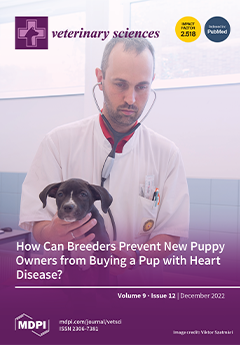Recent studies showed that
Escherichia coli (
E. coli) strains isolated from captive giant pandas have serious resistance to antibiotics and carry various antibiotic resistance genes (ARGs). ARGs or virulence-associated genes (VAGs) carried by antibiotic-resistant
E. coli are considered as a potential health threat to giant pandas, humans, other animals and the environment. In this study, we screened ARGs and VAGs in 84 antibiotic-resistant
E. coli strains isolated from clinically healthy captive giant pandas, identified the association between ARGs and VAGs and analyzed the phylogenetic clustering of
E. coli isolates. Our results showed that the most prevalent ARG in
E. coli strains isolated from giant pandas is
blaTEM (100.00%, 84/84), while the most prevalent VAG is
fimC (91.67%, 77/84). There was a significant positive association among 30 pairs of ARGs, of which the strongest was observed for
sul1/
tetC (OR, 133.33). A significant positive association was demonstrated among 14 pairs of VAGs, and the strongest was observed for
fyuA/
iroN (OR, 294.40). A positive association was also observed among 45 pairs of ARGs and VAGs, of which the strongest was
sul1/
eaeA (OR, 23.06). The association of ARGs and mobile gene elements (MGEs) was further analyzed, and the strongest was found for
flor and
intI1 (OR, 79.86). The result of phylogenetic clustering showed that the most prevalent group was group B2 (67.86%, 57/84), followed by group A (16.67%, 14/84), group D (9.52%, 8/84) and group B1 (5.95%, 5/84). This study implied that antibiotic-resistant
E. coli isolated from captive giant pandas is a reservoir of ARGs and VAGs, and significant associations exist among ARGs, VAGs and MGEs. Monitoring ARGs, VAGs and MGEs carried by
E. coli from giant pandas is beneficial for controlling the development of antimicrobial resistance.
Full article






